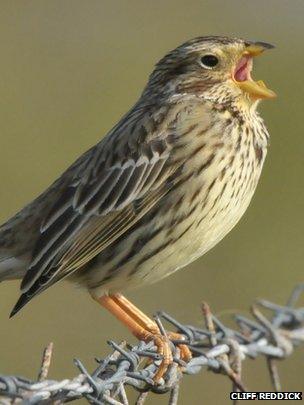Dialect clue to decline in Western Isles corn buntings
- Published

Only male corn buntings sing
Variations in the songs of different groups of corn buntings in the Western Isles have helped scientists to chart the decline in numbers of the birds.
By studying the pattern of male birds' songs, researchers can identify different groups of buntings.
In the past males could find enough mates within their own groups.
But Aberystwyth University scientists have found the dialect groups are beginning to mix together suggesting males are flying further to find mates.
RSPB Scotland said a survey of corn buntings suggested there could be as few as 76 territorial males in the Western Isles.
Since last year, the charity has been providing crofters with a mix of whole and crushed barley to improve the birds' survival in winter.
Jamie Boyle, of RSPB Scotland, said: "Corn buntings are great wee birds - known to generations of crofters as gealag-bhuachair.
"Although maybe not much to look at, they have a very distinctive jangling call, which they utter during the spring months."
He said studying the birds' songs had given further clues to how far numbers have fallen.
Mr Boyle said: "Just as it is possible to tell whether someone is from North or South Uist by listening carefully to their voices, so it is possible to do the same with corn buntings.
"What concerns us is that the researchers are picking up evidence of the different dialect groups beginning to mix together. This could well be a reaction to the overall population decline."
Corn buntings have a unique pattern of micro-geographic song variation, external, according to Aberystwyth University.
It said songs could be divided into two halves. The first part, called the song type, can follow two or three patterns. The second half - the dialect - is the same for every song sung in a dialect group.
Only male corn buntings sing.
In August, RSPB Scotland said only 800 breeding pairs of corn bunting were believed to remain in Scotland.
The charity said an Aberdeenshire population had declined from 134 pairs to only 12 over a 20-year period.
- Published3 August 2012